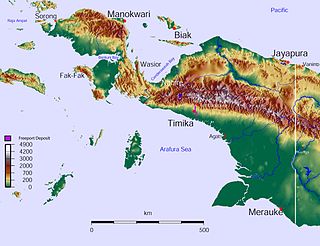
The Free Papua Movement or Free Papua Organization is a name given to independence movement based on Western New Guinea, seeking the secession of the territory currently administered by Indonesia as the provinces of Central Papua, Highland Papua, Papua, South Papua, Southwest Papua, and West Papua, also formerly known as Papua, Irian Jaya and West Irian.

The Kopassus is an Indonesian Army (TNI-AD) special forces group that conducts special operations missions for the Indonesian government, such as direct action, unconventional warfare, sabotage, counter-insurgency, counter-terrorism, intelligence gathering and special reconnaissance (SR). Kopassus was founded by Alexander Evert Kawilarang and Mochammad Idjon Djanbi on 16 April 1952. It gained worldwide attention after several operations such as the Indonesian invasion of East Timor and the release of hostages from Garuda Indonesia Flight 206.
Dortheys Hiyo Eluay was an Indonesian local politician from Irian Jaya turned West Papuan independence activist. Known as the former leader of Papua Presidium Council, he was known as the community leader in West Papua region. He was murdered by members of the Indonesian Army special forces command.
Arnold Clemens Ap was a West Papuan cultural leader, anthropologist and musician. Arnold was the leader of the group Mambesak, and curator of the Cenderawasih University Museum. He also broadcast Papuan culture on his weekly radio show.

Garuda Indonesian Airways Flight 206 was a Garuda Indonesia flight that was hijacked on 28 March 1981, by the Komando Jihad in Indonesia. The McDonnell Douglas DC-9 plane PK-GNJ was hijacked on a domestic flight and forced to land at Don Mueang International Airport in Bangkok, Thailand. The hijackers demanded the release of their confederates from Indonesian jails and issued other demands. Three days later, the aircraft was stormed by Indonesian special forces. In the ensuing operation, all five hijackers were killed, while the pilot and one Kopassus operatives were mortally wounded, with both succumbing to their wounds later. All passengers were rescued.

The Papua conflict is an ongoing conflict in Western New Guinea (Papua) between Indonesia and the Free Papua Movement. Subsequent to the withdrawal of the Dutch administration from the Netherlands New Guinea in 1962 and implementation of Indonesian administration in 1963, the Free Papua Movement has conducted a low-intensity guerrilla war against Indonesia through the targeting of its military, police, as well as civilian populations.

Kelly Kwalik was a senior separatist leader and military commander with the Free Papua Movement (OPM), a separatist organization based in Indonesia's Papua Province.
The History of Western New Guinea refers to the history of the Indonesian western half of the island of New Guinea and other smaller islands to its west. This region was previously named Irian Jaya. The eastern half of the island is Papua New Guinea.

Operation Trikora was a combined Soviet-Indonesian military operation which aimed to seize and annex the Dutch overseas territory of Netherlands New Guinea in 1961 and 1962. After negotiations, the Netherlands signed the New York Agreement with Indonesia on 15 August 1962, relinquishing control of Western New Guinea to the United Nations.

Major TNI Johannes Abraham Dimara was an Indonesian National Hero from Papua.

The West New Guinea dispute (1950–1962), also known as the West Irian dispute, was a diplomatic and political conflict between the Netherlands and Indonesia over the territory of Dutch New Guinea. While the Netherlands had ceded sovereignty over most of the Dutch East Indies to Indonesia on 27 December 1949 following an independence struggle, it retained control over its colony on the western half of New Guinea. The Indonesian government claimed this territory as well, on the basis that it had belonged to the Dutch East Indies and that the new Republic of Indonesia was the legitimate successor to the former Dutch colony.
In early 1976, the Indonesian Army launched an offensive against Free Papua Movement (OPM) military elements in the southern parts of Jayapura Regency, in what is today Papua. While the operation failed to completely destroy OPM's presence, the organization was considerably weakened militarily from its losses.
The Arfai incident was a skirmish between Indonesian Army soldiers and Free Papua Movement fighters backed by local sympathizers on 28 July 1965, where the fighters launched a raid against an Indonesian barracks in an attempt to capture firearms.
In November 2017, tensions developed in Mimika Regency of Papua following a blockade of two villages by the National Liberation Army of West Papua, the military arm of the Free Papua Movement (OPM). The Government of Indonesia described the situation as a "hostage crisis", with the Indonesian Police reporting that 1,300 people were held hostage. Other sources, such as human rights lawyer Veronica Koman, or, later, local authorities, denied the "hostage crisis" claim, as OPM had been primarily establishing roadblocks impeding access to the affected villages.
The following lists events that happened during 1996 in Indonesia.
The 1996 Timika shooting was a mass shooting that took place on 15 April 1996 at the Mozes Kilangin Airport, Timika, Irian Jaya, Indonesia, by a member of Kopassus Sec. Lt. Sanurip. Sixteen people were killed and eleven others were injured.
The following is the broad timeline for major events in the Papua conflict.

The Nduga hostage crisis began on 7 February 2023 when Free Papua Movement insurgents attacked a plane and took its pilot and all five passengers hostage. While the passengers were soon released, New Zealander pilot Phillip Mark Mehrtens remains in captivity.
Egianus Kogoya is a military commander of Free Papua Movement (OPM).

Major General I Gusti Putu Danny Nugraha Karya was an Indonesian major general who previously served as the Head of Regional State Intelligence Agency until his death in combat. He replaced the late Brigjen Abdul Haris Napoleon who at the time, was appointed Expert Staff for Ideology and Politics at BIN. Following Danny's death, Napoleon was subsequently reappointed as Kabinda and served until he passed away due to a heart attack in 2022.










